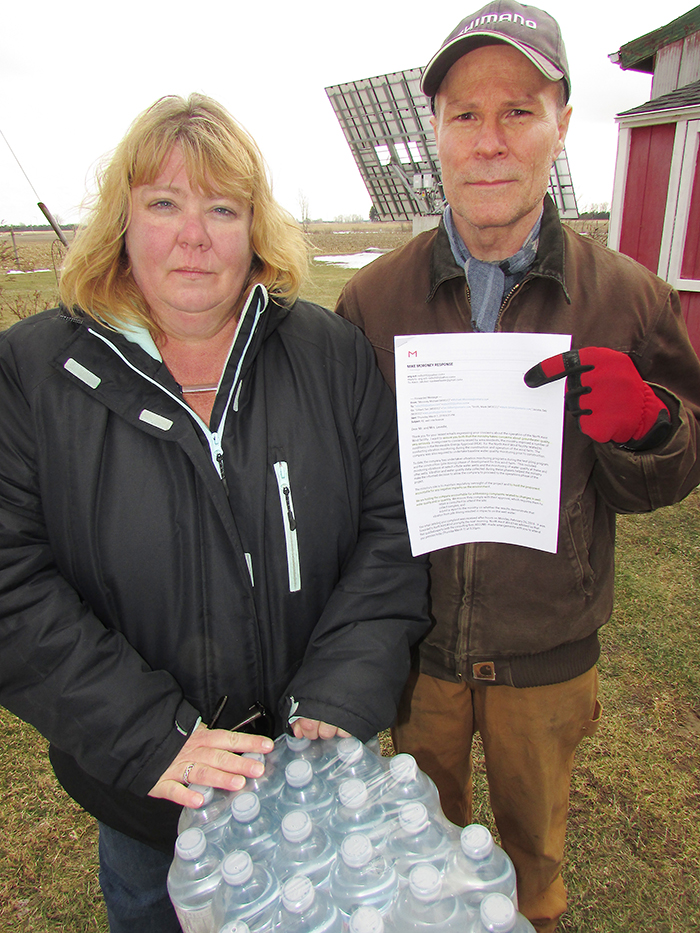
In order to answer the question about how much black shale is safe to be ingested, Water Wells First is teaming up with the University of Windsor to study the issue.
Kevin Jakubec, spokesperson for WWF, made the announcement from the home of Angie and Jim Leveille, after they received an e-mail from the Ministry of Environment explaining they would not be getting any water from the wind farm company while their complaint was investigated.
Jakubec said the Department of Earth and Environmental Sciences, led by Dr. Joel Gagnon, who is also the head of the Metals laboratory at GLIER (Great Lakes Institute for Environmental Research), has agreed to work with the WWF experts to study the black shale and the aquifer that is unique to this area.
This past week, Jakubec was invited to the university to see the state-of-the-art lab and facilities WWF experts will have access to start finding answers and solid data on how the shale ended up in the wells, its long-term health affects since it contains toxic heavy metals, and any suggestions for remediation to save the aquifer and a potable water supply for well users.
The question of whether the water is safe is one that is most disturbing for people whose wells have been affected. Dover resident Marc St. Pierre, who has been buying water for drinking for two and half years, has two filtration systems on his well water supply and worries that even bathing and cooking with the water may be harming his family’s health. His filters, however, can only remove particles larger than four microns.
A recent test of the well water of Jessica and Paul Brooks has shown that in one millilitre of their well water, there are 682,000 particles of black shale, half of which are under one micron in size.
At a press conference at Queen’s Park last week hosted by Essex MPP Taras Natyshak, St. Pierre spoke to the media about his concerns.
“My wife is in delicate health, so to know that I am slowly poisoning her with this water is very disheartening,” St. Pierre said at the press conference. “We have been buying water, we don’t drink it (the well water) but it can be dermally taken in through the skin into the bloodstream and I think the stress level in my home is quite high knowing this.”
Jakubec said that the problem is, as explained to them by a toxicology expert WWF consulted, long-term chronic exposure to the heavy metals (arsenic, lead, mercury, uranium) in the shale, which could lead to cancer.
Dr. David Colby, medical officer of health in Chatham-Kent said the health hazard investigation has already been completed and the water itself is safe to drink. Jakubec, however, said neither the MOECC nor the health unit ever tested the black shale sediment that is in the water.
When asked about the digestive process releasing the heavy metals, similar to the acid digestion test used in a lab to separate the heavy metals from the rock, Colby said the two could not be compared.
“You mentioned the acid digestion test used for mineral analysis. That procedure is not comparable to conditions in the stomach. The test uses strong acid for a longer contact time to actually dissolve the rock and release the metals from the stone matrix for analysis. That does not happen in the stomach because the acid is much weaker and the acid contact time much shorter, so the particles do not dissolve,” Colby said in an e-mail.
Jakubec said with no scientific studies done on the long-term exposure of ingesting and bathing in water containing black shale particles, the partnership with the University of Windsor is a huge step in finding out the effects of the black shale.
“We are doing the work the province and the public health unit should be doing in protecting people’s health and protecting safe and clean drinking water for the people in Chatham-Kent,” Jakubec said.
For the Leveilles, the most recent well owners to have problems, hearing they would not be getting a safe water supply while their well complaint is being investigated was “like a punch in the gut.”
“The sense of abandonment I feel from my province is profound. I trusted you to do the right thing, Kathleen (Wynne). I trusted you would do something to prevent this from happening to more families. You betrayed us,” Angie said in a statement. “I cooked and bathed in that water on Sunday morning when our well stopped working. What have I exposed myself to? I’m having a really hard time with that conclusion.”







Would like to thank the Department of Earth and Environmental Sciences, led by Dr. Joel Gagnon, in trying to help the citizens of North Kent and Dover. No one else seems to be helping them. Dr. Gagnon will be testing and find out what went on, something that MOECC, Dr Colby, Mayor Hope,Councillors, MPP’s, Liberal Wynne and Trudeau.
MPP Natyshak is the only one as of late who is trying to do something too. These citizens in these areas are suffering enough it is time to find out what’s really happening in this area and not just take the findings from the wind company Golder report. You just cannot read that report and say it’s all good as they worked for Samsung and Pattern. You have to do your own due diligence. I will say it again, let them bring in water from their wells for the next council meeting so Dr Colby, the Mayor, Councillors who voted on the 15% partnership and the staff who suggested this partnership. Will you drink it. I DO NOT think so!!!